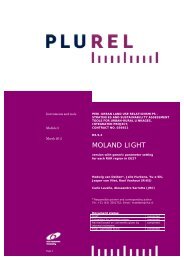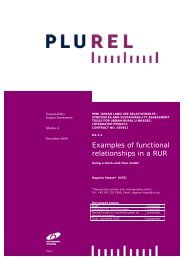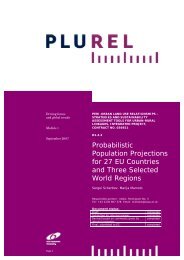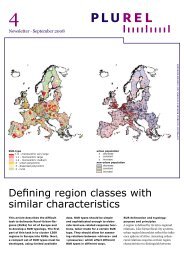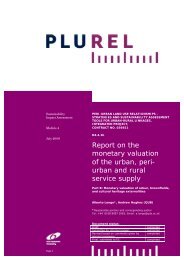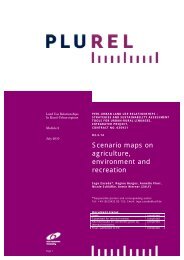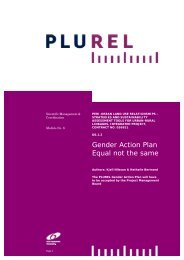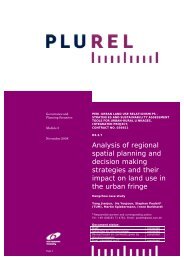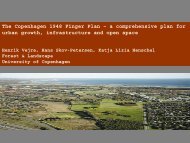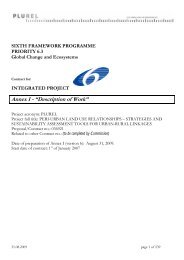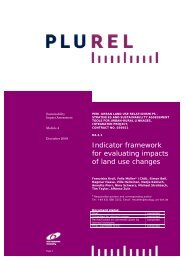Cost benefit analysis of peri-urban land use policy - Plurel
Cost benefit analysis of peri-urban land use policy - Plurel
Cost benefit analysis of peri-urban land use policy - Plurel
Create successful ePaper yourself
Turn your PDF publications into a flip-book with our unique Google optimized e-Paper software.
Discussion<br />
In this report, we have summarised the evidence for GDP change, carbon storage and<br />
open space in the case <strong>of</strong> Leipzig. We have applied monetary values as appropriate from<br />
the literature. Some broad conclusions can be drawn:<br />
1. The methods <strong>use</strong>d in M3 case studies affects the comparability <strong>of</strong> results. The<br />
GDP assumptions made in building scenarios were not necessarily compatible<br />
with the M1 scenarios. Hence here we present the most consistent evidence<br />
possible. This shows the following:<br />
a. Under the “BAU” scenarios growth is consistently lower than estimates<br />
from either NEMESIS based outputs for chosen scenarios or scenarios<br />
developed in case studies. This may be suggestive <strong>of</strong> an optimism over<br />
economic growth in the PLUREL scenarios.<br />
b. For Leipzig, the Eco-Environmental scenario is the most extreme,<br />
outstripping even the most optimistic growth scenario based on<br />
NEMESIS for the same region.<br />
2. For carbon storage, in the case <strong>of</strong> Leipzig variation across scenarios is not that<br />
significant in terms <strong>of</strong> avoided social costs <strong>of</strong> carbon. It is important to note that<br />
the variation in the social cost <strong>of</strong> carbon outstrips the change in carbon retention<br />
<strong>of</strong> soils.<br />
3. For open space, in the case <strong>of</strong> Leipzig costs <strong>of</strong> between €1.15million and<br />
€3.07million can be identified dependent on the scenario. These estimates are<br />
quite uncertain and are based on a number <strong>of</strong> simplifying assumptions – notably<br />
equal distribution <strong>of</strong> population. If housing is more dispersed around the open<br />
areas than the average in Leipzig, then these values may decline. Demographic<br />
change has also not been reflected in these estimates (e.g. decline in ho<strong>use</strong>hold<br />
size).<br />
To summarise, the economic implications <strong>of</strong> changes in <strong>land</strong> <strong>use</strong> in the PLUREL<br />
scenarios range from changes in GDP and changes in the social costs <strong>of</strong> carbon to changes<br />
in ho<strong>use</strong> prices arising from smaller open spaces. The overall changes in GDP in all cases<br />
outstrip losses in terms <strong>of</strong> amenity values <strong>of</strong> open spaces, though it should be noted that a<br />
number <strong>of</strong> other <strong>use</strong>s <strong>of</strong> open space have not been valued.<br />
102



